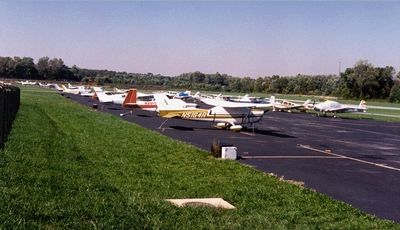Advocacy Group Says Airports' Struggle Continues
 As ANN reported Thursday, transient
operations will soon be allowed at the "DC-3" airports, albeit on a
very restricted basis. While much industry attention has been
devoted to reopening Reagan National Airport to general aviation
(primarily large business jets), AOPA has focused on the GA
airports inside the Washington flight restricted zone (FRZ),
repeatedly asking the TSA, FAA, and Congress to allow transient
operations at the "DC-3" airports - College Park Airport (CGS),
Potomac Airfield (VKX), and Washington Executive/Hyde Field (W32).
Now, a small victory.
As ANN reported Thursday, transient
operations will soon be allowed at the "DC-3" airports, albeit on a
very restricted basis. While much industry attention has been
devoted to reopening Reagan National Airport to general aviation
(primarily large business jets), AOPA has focused on the GA
airports inside the Washington flight restricted zone (FRZ),
repeatedly asking the TSA, FAA, and Congress to allow transient
operations at the "DC-3" airports - College Park Airport (CGS),
Potomac Airfield (VKX), and Washington Executive/Hyde Field (W32).
Now, a small victory.
The Transportation Security Administration has issued a new
rule that transfers responsibility for ground security
procedures at the DC-3 airports from the FAA to TSA. (The FAA soon
will issue a revised NOTAM for the Washington, D.C., flight
restricted zone - FRZ - to allow vetted transient pilots to operate
in FRZ airspace.)
The new TSA rule opens the DC-3 airports to transient
operations, provided that pilots comply with the same extensive
security procedures that based pilots must follow.
"This action is significant because it marks the first time
since 9/11 that transient general aviation operators will have
access to these airports," said AOPA President Phil Boyer. "While
reducing the size of the ADIZ to just the FRZ is AOPA's primary
goal, permitting transient operations in the FRZ is a step in the
right direction."
All operations into the DC-3 airports were suspended following
the September 11, 2001, attacks. In February 2002, the airports
were reopened to based aircraft only. Pilots have to undergo a
security background check, and there are special flight plan
requirements for every flight into and out of the DC-3
airports.
"AOPA has been in regular contact with TSA and other security
agencies to push for improvements to the Washington ADIZ, and we'll
continue that advocacy," said Andy Cebula, AOPA senior vice
president of Government and Technical Affairs. "This small, but
important, change for the DC-3 airports shows that there are
opportunities for improvements, but progress is going to be
slow.
"Fair or not, the security agencies are uncomfortable with
general aviation because they don't know who's in the airplane.
AOPA will continue our education efforts to make sure they
understand that GA is not a threat." In order for transient pilots
to fly into one of the DC-3 airports, they first must visit the
airport (driving, not flying) and present their identification and
pilot credentials to the airport security coordinator (ASC).

After obtaining a personal identification number (PIN) issuance
form, they must go to either the Washington or Baltimore flight
standards district office (FSDO) - depending upon which airport
they want to use - for an FAA verification of documentation.
Following that, they must be fingerprinted at Reagan Washington
National Airport (DCA). There will be a $31 processing fee. Then
pilots must return to the airport they want to fly to, present
their documents to the ASC, and view a security procedures
videotape. After all of that has been attested to, the ASC will
forward the information to the TSA, which will issue the pilot a
PIN.
With a TSA-issued PIN, pilots can fly to the approved airport,
provided they comply with the airspace and flight plan procedures
that will be detailed in the FAA NOTAM to be issued before February
13. February 10, 2005
 Airbus Racer Helicopter Demonstrator First Flight Part of Clean Sky 2 Initiative
Airbus Racer Helicopter Demonstrator First Flight Part of Clean Sky 2 Initiative Diamond's Electric DA40 Finds Fans at Dübendorf
Diamond's Electric DA40 Finds Fans at Dübendorf ANN's Daily Aero-Term (04.23.24): Line Up And Wait (LUAW)
ANN's Daily Aero-Term (04.23.24): Line Up And Wait (LUAW) NTSB Final Report: Extra Flugzeugbau GMBH EA300/L
NTSB Final Report: Extra Flugzeugbau GMBH EA300/L Classic Aero-TV: 'Never Give Up' - Advice From Two of FedEx's Female Captains
Classic Aero-TV: 'Never Give Up' - Advice From Two of FedEx's Female Captains




